
Kantanagar Temple, commonly known as Kantaji Temple or Kantajew Temple at Kantanagar, is a Hindu temple in Dinajpur, Bangladesh. The Kantajew Temple is a religious edifice belonging to the 18th century. The temple belongs to the Hindu Kanta or Krishna and this is most popular with the Radha-Krishna devotees in Bengal. This temple is dedicated to Krishna and his wife Rukmini. Built by Maharaja Pran Nath, its construction started in 1704 CE and ended in the reign of his son Raja Ramnath in 1722 CE. It is an example of terracotta architecture in Bangladesh and once had nine spires, but all were destroyed in an earthquake that took place in 1897.
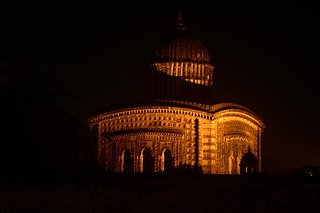
Bishnupur is a city and a municipality and now it is District in the state of West Bengal, India. It is known for its terracotta temples built by the Malla rulers, historic Radha Krishna temples built during 1600–1800 CE and the Baluchari sarees.

The Architecture of Bengal, which comprises the modern country of Bangladesh and the Indian states of West Bengal, Tripura and Assam's Barak Valley, has a long and rich history, blending indigenous elements from the Indian subcontinent, with influences from different parts of the world. Bengali architecture includes ancient urban architecture, religious architecture, rural vernacular architecture, colonial townhouses and country houses and modern urban styles. The bungalow style is a notable architectural export of Bengal. The corner towers of Bengali religious buildings were replicated in medieval Southeast Asia. Bengali curved roofs, suitable for the very heavy rains, were adopted into a distinct local style of Indo-Islamic architecture, and used decoratively elsewhere in north India in Mughal architecture.

Chandrakona is a town and a municipality in the Ghatal subdivision of Paschim Medinipur district in the state of West Bengal, India. The city is located between Ghatal and Garhbeta. Chandraketu was the founder of the kingdom of Chandrakona. In the Ain-E-Akbari, the 16th century Mughal document, it was mentioned as ‘Mana’.
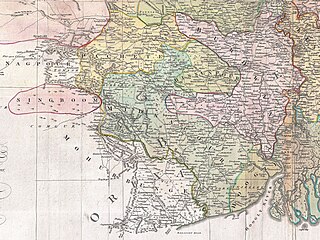
Mallabhum was the kingdom ruled by the Malla kings of Bishnupur, primarily in the present Bankura district in Indian state of West Bengal.

Raghunath Malla Dev, also known as Raghunath Singha Dev, was the fifty-first king of the Mallabhum. He ruled from 1626 to 1656 CE.

Gokulchand Temple is a 17th-century stone built pancharatna temple in Gokulnagar village in the Joypur CD block in the Bishnupur subdivision of the Bankura district in the state of West Bengal, India.
Pathra is a village and a gram panchayat in the Midnapore Sadar CD block in the Medinipur Sadar subdivision of the Paschim Medinipur district in the state of West Bengal, India.

Chandrakona Jorbangla Temple is a 17th-century stone built temple at Dakshinbazar, Chandrakona in Ghatal subdivision of Paschim Medinipur district in West Bengal, India.
Radhakantapur is a village in the Daspur I CD block in the Ghatal subdivision of the Paschim Medinipur district in the state of West Bengal, India.
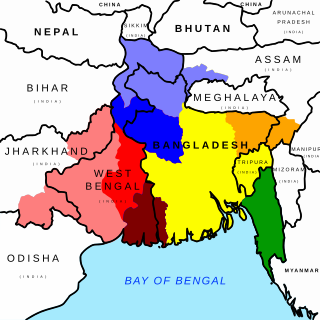
Bengal temple architecture is about temple styles developed and used in Bengal, particularly the chala, ratna and dalan temples.

Brindaban Chandra's Math, or Brindaban Chandra Math, is a complex of 17th–18th century temples at Guptipara in Hooghly district in the Indian state of West Bengal.
Bali Dewanganj is a village and a gram panchayat in the Goghat I CD block in the Arambagh subdivision of Hooghly district in the Indian state of West Bengal.

Parul is a village in the Pursurah CD block in the Arambagh subdivision of Hooghly district in the Indian state of West Bengal.
Baranagar is a village in the Murshidabad-Jiaganj CD block in the Lalbag subdivision of Murshidabad district in the state of West Bengal, India.

Radh Bengal is a region in West Bengal also known as the Temple Town. This region consists of arrays of temples in varying sizes and devoted to different gods and goddess but the common thread unifying this group is that the temples are constructed in terracotta. The region consists of following districts Birbhum, Bankura, Burdwan, Purulia and parts of Murshidabad. The construction style originated in 16th century and lasted till the 19th century. This period is also referred as a golden age of temple in West Bengal. Reason for development of this construction technique was the rich red laterite soil of the region and lack of construction worthy stone. The skill of creating daily objects from like vessels, pottery, seal and toys evolved into a construction technique in the time of need. These temples are baked terracotta panels or bricks. This particular style spread outside the present day West Bengal as well, to Jharkhand, Bihar, Assam and Tripura.
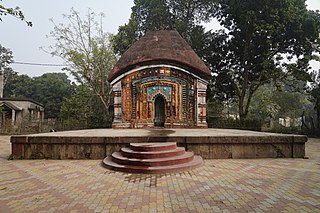
Chala Style is a style of Bengal temple architecture, that originated in Bengal from the 15th centuries. Originating as a regional style in Hindu temple architecture. The main features of this style are curved tops and cornices. Chala-style temples in West Bengal were made of mud walls and thatched roofs. But, in East Bengal it was built with bamboo structures and thatched roofs.

Kotulpur Sridhar Temple is a Vishnu temple at Shiromanipur village in West Bengal. Hindu God Vishnu is worshiped as Sridhar (Shaligram) in this temple. It is located in Kotulpur police station of Bankura district. Built by Bhadra family known as traders and zamindars, the temple stands within the Bhadra palace. The temple is a great example of ratna architecture, which was erected in the early-fourth decade of the 19th century.
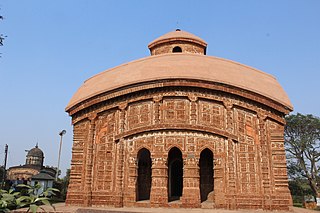
Keshto Ray Temple, also known as Jor-Bangla Temple, is a Krishna temple at Bishnupur city of Medinipur Division. In the past, the Hindu god Krishna was worshiped as Keshto Ray in this temple. According to the Inscriptional plaque, the temple was founded by 51st King of Mallabhum kingdom Raghunath Singha in 1655. The temple is a great example of Jor-Bangla temple architecture, which belong to the chala style.

























